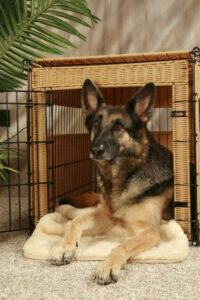Crate Training
Helpful advice to crate train your dog
Crate training teaches your dog to comfortably spend time in a kennel. Dogs are naturally den animals, and they can learn that this is a safe place to retreat when they are anxious and where they can rest undisturbed. This will also provide a way to help control their activity levels when they are recovering from injury or surgery. Crate training your puppy from the very beginning will make potty training and behavior training substantially easier.
The first step is to have an appropriately sized crate. The crate should be big enough for your puppy to turn around and lie down comfortably, but it should not be so large as to encourage them to use one end of the kennel to eliminate. A large breed puppy will need a crate that has an adjustable divider so that you can expand the available area as they grow. Do not initially put a towel or blanket in the kennel as this provides them with an absorbent surface to eliminate on as well as something that they may potentially chew on or ingest. If your puppy needs to be left alone for longer periods than you can reasonably expect them to hold urine or stool, they should not be left in a crate at those times. We do not want them to be forced to soil themselves or get used to eliminating in their crate. We recommend confining them to a small room with an easy to clean floor at those times.
 The crate should never be used as a punishment. Treats and praise should accompany each trip into the crate. Feed some of your puppy’s meals in the crate. The door can be left open and the food placed in the back of the crate. This helps them to see the crate as a positive area, as well as using their natural instinct not to eliminate where they eat.
The crate should never be used as a punishment. Treats and praise should accompany each trip into the crate. Feed some of your puppy’s meals in the crate. The door can be left open and the food placed in the back of the crate. This helps them to see the crate as a positive area, as well as using their natural instinct not to eliminate where they eat.
Use the crate for varying periods of time. Use the crate for periods of time when you are home as well. It is better if each trip in the crate does not signal to your puppy that they will be left alone for an extended period. Provide appropriate chew toys to help keep them busy and entertained while in the kennel. There are readily available toys that have small grooves to allow for the application of a small amount of peanut butter. This can make the toys more attractive and increase the amount of time that they engage with them.
For overnight use, only take them straight outside to eliminate and then return them back to the crate. Do not take them out overnight for playtime or meals. This will help you to establish a normal sleep schedule.
It is not unusual for a puppy to vocalize and be distressed for a few days when they are adjusting to the kennel. They have gone through a big change in leaving their mother and littermates and moving into a new home. Do not scold or respond to vocalizations as this will encourage the behavior and make the adjustment period last longer. This will go against your natural instincts to nurture them, but if you do not make it through those early days, crate training and potty training will become much more difficult. If your puppy seems to be experiencing an unusual amount of anxiety in the crate, speak to your veterinarian. In some cases, anxiety medications or alterations in your training technique may be needed.
Having a new puppy can be exhausting. You will not always be able to remain present and watchful. Puppies are prone to get getting themselves in trouble. It is okay to give yourself a break periodically and use the kennel to prevent accidents, destructive behavior, and ingestion of non-food items.
